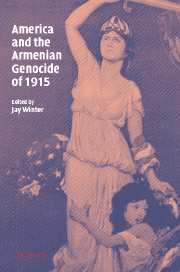Book contents
- Frontmatter
- Contents
- List of contributors
- Map
- Acknowledgments
- Introduction: witness to genocide
- Part 1 The framework
- 1 Twentieth-century genocides
- 2 Under cover of war: the Armenian Genocide in the context of total war
- 3 The Armenian Genocide: an interpretation
- Part II During the Catastrophe
- Part III After the Catastrophe
- Index
- Studies in the Social and Cultural History of Modern Warfare
1 - Twentieth-century genocides
Published online by Cambridge University Press: 04 September 2009
- Frontmatter
- Contents
- List of contributors
- Map
- Acknowledgments
- Introduction: witness to genocide
- Part 1 The framework
- 1 Twentieth-century genocides
- 2 Under cover of war: the Armenian Genocide in the context of total war
- 3 The Armenian Genocide: an interpretation
- Part II During the Catastrophe
- Part III After the Catastrophe
- Index
- Studies in the Social and Cultural History of Modern Warfare
Summary
The twentieth century witnessed some of humanity's greatest achievements – in medicine, science, agricultural production, communications – and some of its worst excesses. By any scale of values, looking back one – or even two – millennia, it was a century of improvement, at times vast improvement, in the quality of life for millions of people; yet the twentieth century was also one of decline in many parts of the world.
In much of my recent scholarship, I have touched on many of the attempts made in the century that is now behind us, to destroy a whole people. No episode, however horrific, resembles another. Each has its own appalling characteristics. In recent years, the researches of pioneer scholars – among them George Andreopoulos, Martin van Bruinessen, Frank Chalk, Israel Charny, Helen Fein, Leo Kuper, and Richard Hovannisian – have shown just how widespread the barbarism of governments can be, once they set as their aim the destruction or curtailment of a particular people.
Winston Churchill was once asked why the twentieth century was called the century of the common man. He replied to his questioner: “It is called the century of the common man because in it the common man has suffered most.” The often tragic fate of that “common man” – and woman and child, – the young and the old, runs like a dark thread through twentieth-century history.
- Type
- Chapter
- Information
- America and the Armenian Genocide of 1915 , pp. 9 - 36Publisher: Cambridge University PressPrint publication year: 2004

